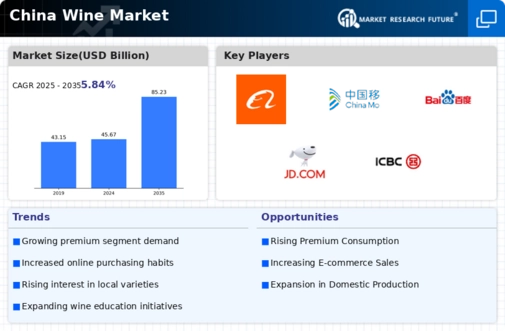Health Consciousness and Wine
The growing health consciousness among Chinese consumers is emerging as a notable driver for the wine market. Many consumers are increasingly aware of the health benefits associated with moderate wine consumption, particularly red wine, which is often linked to cardiovascular health. This awareness appears to be influencing purchasing decisions, as consumers seek wines that align with their health-oriented lifestyles. Reports indicate that organic and low-sugar wines are gaining traction, with sales in these categories rising by approximately 15% annually. This trend suggests that the wine market may need to adapt to meet the demands of health-conscious consumers, potentially leading to innovations in product offerings and marketing strategies that emphasize the health benefits of wine.
Rising Middle-Class Affluence
The increasing affluence of the middle class in China appears to be a pivotal driver for the wine market. As disposable incomes rise, consumers are more inclined to explore premium wine options, leading to a shift in purchasing behavior. Reports indicate that the middle class is expected to account for over 50% of total wine consumption by 2025. This demographic shift suggests a growing appreciation for wine as a lifestyle choice, rather than merely a beverage. Consequently, the wine market is likely to see a surge in demand for both domestic and imported wines, as consumers seek quality and variety. The rise in wine consumption among this demographic may also encourage local producers to enhance their offerings, thereby contributing to the overall growth of the wine market.
Expansion of Wine Distribution Channels
The expansion of distribution channels is a crucial driver for the wine market in China. With the rise of modern retail formats and online platforms, consumers now have greater access to a diverse range of wine products. The number of wine retail outlets has reportedly increased by over 20% in urban areas, facilitating easier access for consumers. Additionally, e-commerce platforms are becoming increasingly popular, with online wine sales projected to grow by 25% annually. This diversification in distribution not only enhances consumer choice but also encourages competition among suppliers, which may lead to better pricing and quality in the wine market. As distribution channels continue to evolve, the market is likely to see a broader range of products catering to various consumer preferences.
Influence of Social Media and Marketing
The influence of social media and targeted marketing strategies is becoming increasingly significant in shaping consumer preferences within the wine market. Platforms such as WeChat and Douyin are playing a crucial role in promoting wine brands and educating consumers about wine culture. Engaging content and influencer partnerships are driving awareness and interest, particularly among younger demographics. Data indicates that brands utilizing social media marketing have seen a 40% increase in engagement and sales. This trend suggests that effective digital marketing strategies are essential for brands aiming to capture the attention of the modern consumer. As social media continues to evolve, its impact on the wine market is likely to grow, necessitating innovative approaches to reach and engage potential customers.
Cultural Shifts Towards Wine Consumption
Cultural shifts in China are significantly influencing the wine market. Traditionally dominated by spirits, the beverage landscape is evolving as wine gains popularity, particularly among younger consumers. This demographic is increasingly associating wine with sophistication and social status, which is reflected in their purchasing decisions. Data suggests that wine consumption among individuals aged 25-35 has increased by approximately 30% in recent years. This trend indicates a potential long-term shift in drinking habits, as wine becomes a staple in social gatherings and celebrations. The wine market is likely to benefit from this cultural transformation, as it opens up new avenues for marketing and product development tailored to the preferences of this emerging consumer base.
















Leave a Comment